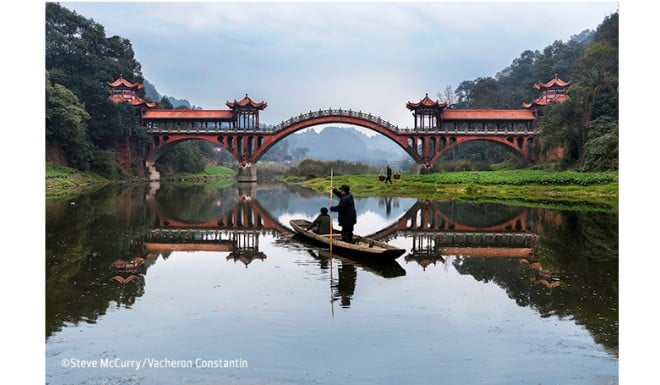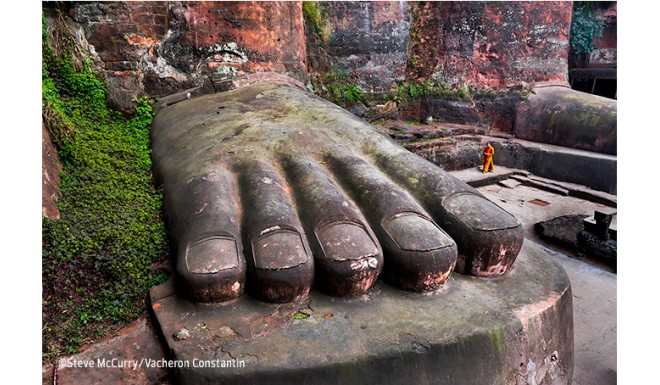
The Leshan Grand Buddha has been standing tall for 1,000 years and greets travellers with a smile
Conceived by the Buddhist monk Hai Tong who created the statue as an act of piety - and a solution to the turbulent waters at the base of the cliff

The first time I saw the Leshan Grand Buddha, in southern Sichuan Province, I was standing on a strip of wet stones in the middle of the River Dadu.
A group of children marched over the stones gingerly, stopping every few steps to snatch one up and toss it into the rushing waters, while silent, skinny old men stared at the ends of their fishing lines.
The Buddha peered down from its alcove in the red cliffs and was both a symbol of protective divinity, and the backdrop to an ordinary day in the river town of Leshan.
That strip I stood on is temporary, rising from the waters periodically throughout the year when the Dadu recedes slightly, only to be inundated again just a few short hours, or a day later. On that spring day, just as the sun passed its zenith, families paid two yuan (HK$2.4) to cross from the river's banks in a five-seater boat to the small stone islet.
The Leshan Buddha has been at this spot for more than 1,000 years. The Buddhist monk Hai Tong, associated with the nearby temples on Mount Emei, conceived of the project as a pious act of faith, and a pragmatic solution to the turbulent waters at the base of the cliff, where many ships had foundered and sunk.
Hai Tong did not live to see the completion of his vision: the Buddha stood half-finished until a regional military commander provided the necessary funds, more than 90 years after the monk and his disciples broke ground. The original structure included a 13-storey wooden housing for the Buddha, in the style of classic Chinese Buddhist temple architecture, but the structure was destroyed in the chaos following the fall of the Yuan dynasty and the wars that led to the founding of the Ming dynasty.

The next time I saw the Buddha, the strip was underwater, and the little boat was moored at the edge, bouncing in the powerful current of the Dadu. Instead of a small fee and a view from the river, I paid the price at the gate, 125 yuan at the time, and descended the staircase that winds down from the Buddha’s crowned head to his metre-tall toes. It was a slow descent, and a crowded one. Every few steps, a camera flashed and someone in line exclaimed at the detail in the statues' eyebrows; the smooth slope of Maitreya’s nose; or the warm feeling one gets after slowly passing by the Buddha’s benign smile.
The Leshan Grand Buddha is now one of the most popular tourist sites in China and a Unesco World Heritage Site since 1996. Every year, millions of tourists climb the stairs alongside the great statue and just as many take boat rides to snap its picture of the Buddha from the centre of the river. Despite the constant crush of tourists - it’s rare for the area to be empty on any day of the year - the area surrounding the Buddha in the city of Leshan is surprisingly unchanged.
Although many new restaurants have sprung up alongside bus touring agencies and other businesses, the river and the neighbourhoods still retain very much of the local Sichuan atmosphere.

The restaurants serve a variety of Sichuan dishes, but the local Leshan cuisine has two that are famous locally and are must-haves when visiting the Buddha: Leshan bobo chicken and Leshan sweet skin duck. The chicken is served on skewers with vegetables and chilled in a bowl of spicy oil, while the duck is roasted and served with a side of Leshan’s special sauce.
The best times to visit the Buddha are early in the morning, as far as possible from the Golden Weeks, in May 1-7 and October 1-7. It’s also best to avoid visiting during the Spring Festival, which is usually in late January and early February. A 125-yuan ticket grants visitors access to the staircase beside the Buddha as well as the adjacent park. Boat rides and photographs run about 30 yuan per trip, depending on the provider. A new high-speed train leaves Chengdu’s South Rail Station every hour for Leshan. The trip takes less than an hour and many taxis and buses waiting at the Leshan Rail Station to take visitors to the Buddha.
If you time it right, when the rains have slackened in late spring, you can step across the stony strip, just to the left of the great statue, and gaze up at the city’s protector while old men fish and young children play.